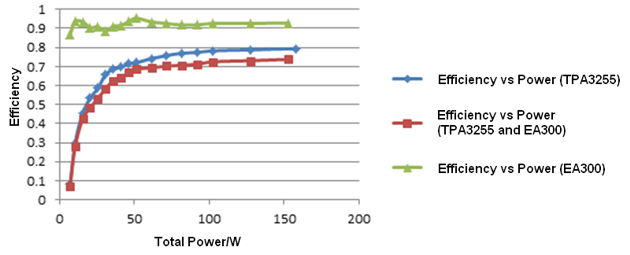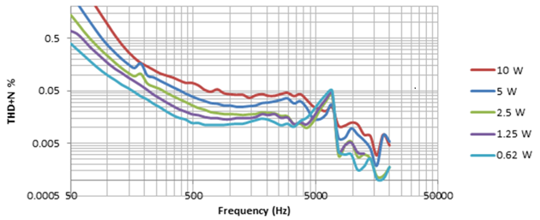SLAA898 September 2022 TAS3251 , TPA3255
4.2.2 Apply a Transformer With Less Power Loss
Another efficiency limitation is the low efficiency of the transformer. This can be improved by applying a new step-up transformer from EDCOR® (EA300, see Figure 3-2, Table 3-2, and Table 3-5) to replace the 18737.
 Figure 4-4 Efficiency Characterization for the
EDCOR® Step-Up Transformer (EA300)
Figure 4-4 Efficiency Characterization for the
EDCOR® Step-Up Transformer (EA300)Configure EA300 as 4 Ω in the primary side, and 70 V in secondary side (a 16-Ω resistor load can make a 4-Ω equivalent load for the amplifier according to Table 3-2). See the characterization result from Figure 4-4. The efficiency of the EA300 can be 0.94.
Continue to use the EA300 with ten 10 W-configured 330-040s and 4-Ω resistors (N is set as 10 to simplify the system; actually more step-down transformers and resistors can be used in parallel), and test the performance and efficiency of the system. Since the resistance ratio of EA300 is much larger (from 1/12.5 to 1/4.16), the equivalent resistance of the amplifier is about 12 Ω, thus ηamp can be as high as 0.9. So in theory, the system efficiency is:
The measured efficiency was 0.67, which is close to the calculated value of 0.71. Figure 4-5 shows the THD+N performance using the EA300. The performance is better than the previous transformer.
 Figure 4-5 THD+N Versus Frequency Results Based on TPA3255 With One EA300 and 10 330-040s (4 Ω as Primary Side and 70 V as Secondary Side)
Figure 4-5 THD+N Versus Frequency Results Based on TPA3255 With One EA300 and 10 330-040s (4 Ω as Primary Side and 70 V as Secondary Side)